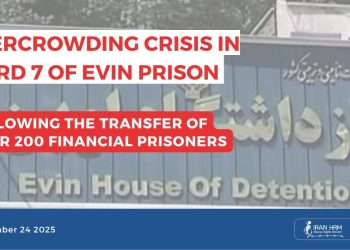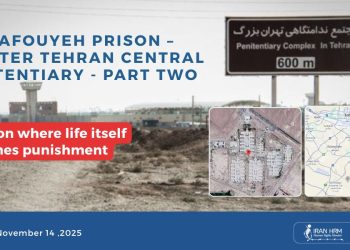The Living Reality: A Prison Where Suffering Never Ends
Fashafouyeh Prison, officially known as the Greater Tehran Central Penitentiary, is not only one of Iran’s largest prisons but also a symbol of the regime’s structural policy of repression and human degradation. Prisoners call it ‘the end of the world’ — a place where time has stopped and the boundary between life and death has vanished.
Methodology
This report is based on testimonies from released prisoners, family correspondence, and independent field data. All information has been verified and updated up to July 2025.
The report consists of two sections:
• The first section examines the structure and on-the-ground realities of the prison.
• The second section provides legal analysis and international responses to these violations.
1. Structure and Overcrowding
Located 32 kilometers south of Tehran and covering over 110 hectares, Fashafouyeh consists of six main units. Each hall holds about 370 prisoners, despite a standard capacity of only 180. Half of the inmates sleep on the floor beside the toilets.
2. The Economy of Suffering and Internal Corruption
In this prison, every privilege has a price — from beds to phone access and even turns for showers. Cigarettes serve as the unofficial currency, and bread or soap can be sold at up to ten times their real value. One former prisoner wrote: “In Fashafouyeh, if you have no money, even air is not yours.”
3. Food, Water, and Hygiene
Daily meals, known as ‘Jireh Doli’, consist of low-quality rice and watery stew. Water is salty and contaminated, and frequent interruptions cause outbreaks of lice, scabies, and skin infections.
4. Babak Dadbakhsh’s Letter: A Testimony from Inside
In August 2025, Babak Dadbakhsh, a 45-year-old political prisoner, wrote an open letter to the head of the judiciary:
“In Fashafouyeh, beds, tea, even sitting at the table costs money. Officials sell ward-leader posts and smuggle medicines to the black market. Out of 3,500 prisoners, only a few have access to books. Every week, we must pay bribes to survive.”
He added: “The prison store sells expired medicine; salty water and the stench of sewage fill the air, and anyone who protests is sent to solitary confinement. The law is dead here.”
5. The Clinic and Medical Situation
More than 20 ill prisoners are held in Ward 4, Unit 2, in critical condition — without a permanent doctor, medication, or medical transfers.
List of sick prisoners:
| Name | Age | Illness | Medical Status |
| Mir Yousef Younesi | 72 | Diabetes, colitis, arthritis | No medication, at risk of death |
| Reza Akbari Monfared | 68 | Heart and joint disease | ‘Unfit for punishment’ ruling ignored |
| Matlab Ahmadian | 43 | Diaphragmatic hernia, ulcer | Needs 9 urgent surgeries |
| Mohammad-Ali Mahmoudi | 56 | Leukemia, heart failure | Denied specialized treatment |
| Mehdi Vafaei Sani | 39 | Gastrointestinal issues | Denied hospital transfer |
| Sepehr Ziaei | 65 | Hernia, digestive illness | Awaiting unfulfilled surgery |
| Sirous Fathi | 44 | Bone marrow disease | Risk of internal bleeding |
“In Fashafouyeh, illness is not death; it is torture.” — from a letter by an ill prisoner.
6. Organized Violence
Violence in Fashafouyeh is not accidental; it is part of the control system. In 2024, drug gangs attacked the political ward (Unit 2) with the support of guards. Interrogations continue with blindfolds, beatings, and forced sleep deprivation.
“The interrogators took us twice a week, blindfolded and kicked. Torture is not just solitary confinement; it is constant humiliation.”
7. Human Impact
Families, especially women and children, live under economic hardship and constant psychological distress. Denial of visits, threats, and long isolation cause deep trauma among relatives of prisoners.
Conclusion
Fashafouyeh is not just a prison — it is a structure for the gradual destruction of human beings. What occurs within these walls is a deliberate policy to silence resistance. The findings of this section form the foundation for the legal analysis in Part Two.







